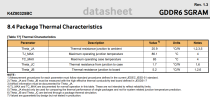Hello,
I have a Sapphire Nitro+ 7900 xtx and I was checking the GPU temperatures and they overall look good, except for Memory Junction which is around 100-108C while gaming. There is no throttling of any kind on the card, the card works perfectly in all games and I have no issues at all of any kind.
I tried to look around the card (without dissasembling) and I can tell it has cooler pads on the 12 VRAMS. I still have over 2 years and a half left on warranty so I don't want to dissasemble. Also, I asked Sapphire and they said there is no AMD specification on Memory Junction temperatures so according to the logs my card works perfectly, so probably RMA for this is not even an option.
The GPU temps never go above 70C and HotSpot stays under 85C even on FurMark after 15 minutes. I also tried to look for other software that can give me the same information of this sensor and I couldn't find any, which makes me question if this Memory Junction temperature is accurate. On Furmark it hits 108C in 2-3 minutes, if I put the fans at 100% always it stays at 104C.
1. Could someone confirm? Or could the sensor be defective?
2. Does anyone know another software that also tracks this sensor so I can compare?
3. Does anyone else happen to have the same issue? I tried to look around and almost no one talks about Memory Junction temps on AMD cards, only gpu temp and hot spot.
Thank you,
I have a Sapphire Nitro+ 7900 xtx and I was checking the GPU temperatures and they overall look good, except for Memory Junction which is around 100-108C while gaming. There is no throttling of any kind on the card, the card works perfectly in all games and I have no issues at all of any kind.
I tried to look around the card (without dissasembling) and I can tell it has cooler pads on the 12 VRAMS. I still have over 2 years and a half left on warranty so I don't want to dissasemble. Also, I asked Sapphire and they said there is no AMD specification on Memory Junction temperatures so according to the logs my card works perfectly, so probably RMA for this is not even an option.
The GPU temps never go above 70C and HotSpot stays under 85C even on FurMark after 15 minutes. I also tried to look for other software that can give me the same information of this sensor and I couldn't find any, which makes me question if this Memory Junction temperature is accurate. On Furmark it hits 108C in 2-3 minutes, if I put the fans at 100% always it stays at 104C.
1. Could someone confirm? Or could the sensor be defective?
2. Does anyone know another software that also tracks this sensor so I can compare?
3. Does anyone else happen to have the same issue? I tried to look around and almost no one talks about Memory Junction temps on AMD cards, only gpu temp and hot spot.
Thank you,
Last edited:

